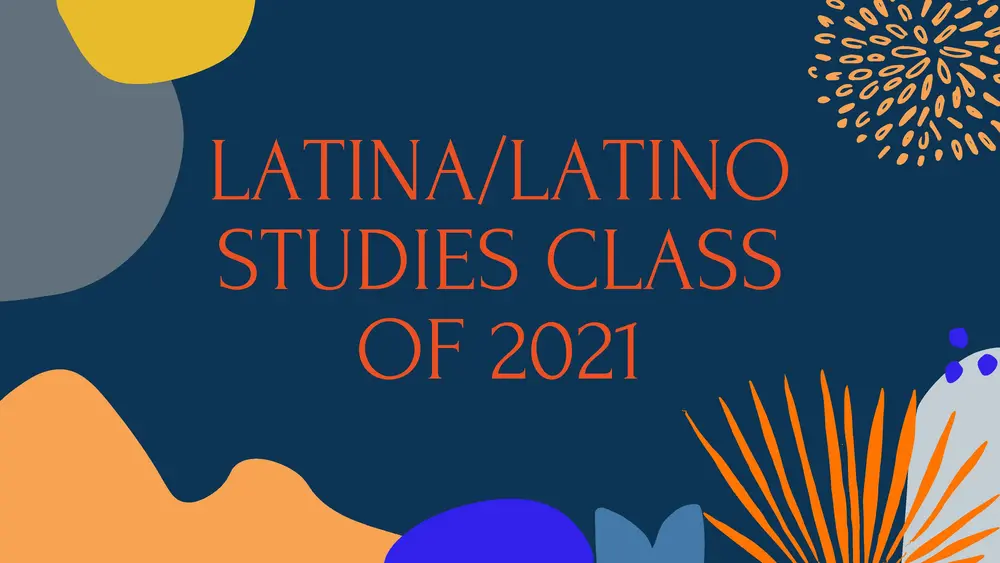

On May 1, 2021 we celebrated the graduation of the LLS major Class of 2021 in a Zoom symposium and celebration. All LLS majors are required to complete a senior paper or a thesis on a topic of their interest related to Latina/o Studies. The senior class spent all of spring semester working on their senior projects or working one-on one with a professor over the course of 2 semesters on the senior thesis, with the plan to present their research at the traditional end-of-the-academic year LLS major symposium. Given the continued limitations posed by the COVID-19 pandemic, the symposium occurred over Zoom with department faculty and staff and friends and family of the graduates in attendance. It was a casual event where the students presented their projects and entertained questions from the participants. Below are the titles and abstracts of the projects.
Congratulations to all of the graduates!
Lydia Alvarez, “El Acción de Gentrificación: Exploring the Contradictions of Community Organizing, Art, and Social Media in the Pilsen Neighborhood of Chicago”
Chicago is a politicized city with an extensive history of community organizing, as its residents are usually involved in social justice initiatives. In Latinx dominated communities, such as Pilsen, residents organize to focus on rights, inclusivity and preservation of culture. As new issues arise to harm community members, activists are quickly mobilized through virtual means to organize and address them. Businesses with historical ties to Pilsen, like El Milagro tortilleria, possess cultural capital within the community. With the rise and necessity of social media due to the COVID-19 pandemic, community organizing in communities like Pilsen has drastically changed, using this cultural capital to create an understanding of the needs of the Latinx community. In my thesis, I track the transition of community organizing throughout the presence of the Latinx population in Pilsen to better understand how social media has worked to effectively organize the community. The overall purpose is to understand the role and effects of political and social organizing within the Latinx community of Pilsen.
Karen Bahena, “Mi Cuerpo, Tu Cuerpo: The Latina Body in Media”
Karen Bucio, “Barriers to Healthcare Access Among Undocumented Immigrants”
As some may know, barriers to access health care for undocumented immigrants go past policies and range from transportation limitations, language barrier, discrimination by health care providers/institutions, fear of deportation and financial constraints. This paper focuses on reviewing some of the barriers that undocumented immigrants face in the United States as well as some data that other researchers have collected for the underlying reasons as to why undocumented immigrants face barriers when it comes to accessing health care. Furthermore, this paper also identifies some strategies or solutions that can be put forward in order to minimize the barriers that undocumented immigrants face when it comes to obtaining medical care in the U.S. Research suggests that in fact there is evidence of discriminatory practices among health care providers and the health care system as well. However, the focus was primarily on the individual such as fear of deportation, language barriers, stigma and not being able to access services due to financial and social challenges. Nonetheless, in order to minimize the barriers, research suggests advocacy for policy reform, offering insurance options for undocumented immigrants, training advance health care providers on the new policies and how to deal with undocumented immigrants as well as teaching undocumented immigrant on how to navigate the healthcare system.
Melody Contreras, “Fornésian Dreamscapes: Navigating Queer World Making”
Using José Esteban Muñoz’s theory of disidentifications and Muñoz’s theoretical model of “queer futurity,” I analyze some of the avant-garde plays from the sixties written by Cuban and Queer playwright, director and mentor, Maria Irene Fornés. I connect and analyze the themes love and violence, ignorance and clarity, arrogance and humility in Tango Palace, The Successful Life of 3, and Dr. Kheal that exude a survival tactic to navigate the heteronormative world for minoritarian subjects. I also highlight the function of locality through the physical spaces that produced her work in New York City at the time. This essay argues that Fornés was constantly pushing the boundaries of being confined to a singular label and created new worlds, queer dreamscapes, that allowed those not accepted by societal standards at the time to have a voice.
Isabella “Issy” Marquez, “Reggaeton’s Resistance: Bad Bunny & the Aesthetics & Politics of Perreo”
Puerto Rican pop culture figure and Reggaeton artist Bad Bunny disidentifies from heteronormativity in both his musical career and aesthetics. Focusing on Puerto Rico’s heteronormative dominant culture and Bad Bunny’s musical career, I argue that he disidentifies from the mainstream status quo of common day Reggaeton artists to recreate the genre into a space of inclusivity. Citing José Esteban Muñoz’s theories of disidentification in Disidentifications: Queers of Color and the Performance of Politics, I analyze the performances, aesthetics, music, lyrics, and persona that is Bad Bunny. Through coining the phrase “Perreo Savior” to note his efforts to make Reggaeton inclusive, along with the phrase “Bad Bunnying” to discuss his blueprint of emotions utilized by men of color, I note Bad Bunny’s critical efforts are making worldwide strides for queerness around the world. As a global superstar and cultural icon, Bad Bunny's modes of disidentifying with the mainstream are simultaneously strategic and intrinsic, showcasing the multiple ways a minoritarian subject transforms identity markers to fit their survival needs.
Jocelyn Rodriguez, “Reproductive Injustices of Latinas in the U.S.”
Latina women are constantly stereotyped as hyper-fertile and unable to financially provide for their children. And for this reason, their fertility has been historically regulated in problematic ways through such things as forced sterilization and birth control experimentation (Gutierrez 2008). The United States has a long history of choosing which populations should not reproduce. Drawing on the works of Natalie Lira and Alexandra Stern (2014), Elena Gutierrez (2008), and Iris Lopez (1993), I will examine the history of the eugenics movement used to justify the forced sterilization of Mexican-origin women in the 1920s, the birth control and sterilization experimentation of Puerto Rican women in the 1930s, and the contemporary sterilization of women in detention centers.
Gabriel Sanabria, “Pushing the Boundaries of Gender: The Life of Jenni Rivera”
Sexism is discriminating against someone based on gender, but it happens mostly towards women of all ages because of beliefs in male superiority. This belief affects gender roles and stereotypes. Therefore, my paper will examine the gender roles that women and men are expected to play from the lens of society. This paper will focus on the Netflix documentary series “Jenni Rivera: Mariposa del Barrio” which portrays Jenni Rivera’s lifetime over different periods such as being a teenager, becoming a mom, dealing with physical and mental abuse, and becoming a musician. Drawing from my findings on the series, I argue that the show initially seems to comply with more traditional gender roles, but later she subverts those roles and challenges gender oppression for her to fulfill her role. I argue that Jenni did not want to continue the same cycle of following the traditional role, so she shifts her role to become more independent and not following her culture’s expectations for a better future. I will also draw upon other scholarly sources and media that have drawn attention to the impact of machismo.
Jailine Santiago, "Resisting Neoliberal Conceptualizations of Worthiness: Articulations of Care for My (un)Deserving Parents"
The ways that undocumented people, and particularly, undocumented people who commit crimes have been criminalized and dehumanized within the United States has been widely studied. Academics have explored the ways that undocumented people have negotiated their criminalization (Dowling and Inda 2013), particularly by trying to align themselves as best they can to normative notions of worthiness that are informed by white supremacy, neoliberal capitalism, patriarchy, and citizenship, particularly through establishing rights through the family-right framework (Cacho 2012, Pallares 2015, Reddy 2005, Stevenson 2018). This proves to be difficult when undocumented people, specifically those who commit crimes, not only fall outside these normative notions of worthiness but are the antithesis of them. And yet, undocumented people are seen as worthy within families and communities, even when they fail to live up to these constructs. In this paper, I explore how we attach worthiness to undocumented people within our interpersonal relationships. Drawing on Lisa Cacho’s (2012) conceptualization of “social death” to understand the way that undocumented people who commit crimes are rendered right-less and undeserving of humanity, I explore how we attribute deservingness to undocumented people who do commit criminal acts within our interpersonal relationships.
Ivan Saucedo, “City Under Siege”
The focus of this research paper will be to provide a critical analysis of the gang culture and resulting gun violence on the streets of Chicago’s Southside. The effects of neighborhood policing, drugs, failing schools, and family dynamics have left Chicago’s youth of tomorrow extremely vulnerable to an untimely death. The research paper will try to explore how institutional systems in the city have made modern day panopticons of black and brown neighborhoods whilst continually failing to address social issues with CPD (Chicago Police Department) and CPS (Chicago Public Schools). Incorporating the theoretical works of Michel Foucault’s, “Crime and Punishment”, this research will attempt to highlight the disparities that black and brown youth are faced against whilst growing up on the Southside in comparison to other neighborhoods on the north side of the city and surrounding suburbs. Cases of gun violence continually plague marginalized neighborhoods. Additionally, the location of Cook County jail in the heart of the southwest side’s Little Village only further emphasizes the fact that the hood was designed in a way to literally trap brown youth within its war zone boundaries. In addressing the social inequities that perpetuate gun violence the hope of the research is to draw attention to the fact that the youth of black and brown neighborhoods of inner city Chicago are at risk of achieving their true potential as productive members of society.
Cristian Solorzano, “Border Patrol: What it Takes to Be a Racist”
The stereotypes created by society have influenced anti-immigrant behavior in the U.S.-Mexican border. U.S. Customs and Border Protection has and continues to use excessive force on immigrants attempting to cross the border. In this essay, drawing on Leo Chavez’s theoretical framework, I analyze the public discourse of Border Patrol agents when describing or mocking certain tragedies within the immigrant community while attempting to cross the border. Also, I will examine hate crimes executed by Border Patrol agents themselves while utilizing race and its definition to understand such moments.